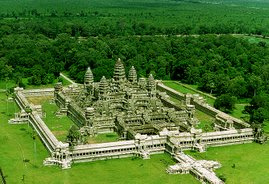 ANGKOR CAMBODIA
ANGKOR CAMBODIA The Majestic temples of Angkor in northwest Cambodia belong to the classic period of Khmer art and civilization. Today, a millennium after they were built, they awe visitors with their perfection and enormity. The temples are the creation of a succession of dominated most of Khmer Kings who presided over an empire that dominated most of present-day Southeast Asia from 800 to 1430, reaching its peak in the 12th century. The period began with the ascension to the throne by King Jayavarman II.
Angkor Wat is the largest temple in the world, with a volume of stone equaling that of the Cheops pyramid in Egypt. It is unlike all other Khmer temples in that it faces west, and it is inspired by 12th century Hinduism. Conceived by Suryavarman II,Angkor Wat took several decades to build. Intricate bas reliefs surround Angkor Wat on four sides. Each tells a story. The way the light glows on the ancient stones makes sunrise and sunset the best time to wander through Angkor Wat's 2 square kilometers, climb its tower.
The ancient walled city of Angkor Thom, literally "Great City, "built in the 12th century by Jayavarman VII, contains the famous Bayon temple with its more than 200 enormous mysterious smiling faces. It also contains the 300 meter-long Elephant terrace with its large sculptured royal elephants and Garudas, the mythical guard half-man, half-bird. Also within the walled area is the terrace of the Leper King. A sandstone replica of the Leper King is here.
Ta Prohm is the temple that has been left largely in its natural state since its discovery by French archeologists. Surrounded by jungle, its labyrinth of stone hallways is overgrown with the roots and limbs of massive bayan trees, which envelop the stone like tentacles. It is one of the largest temples at Angkor, dedicated in 1186. Its close connection with nature makes it easy for the imagination to roam back to the days when it housed the Angkor kings in splendor.
This is the fabled pink temple of women, so called because it is made of pink sandstone & considered a tribute to the beauty of women. Its small size, delicate carving and remarkable state of preservation make Banteay Srei one of travelers' favorite temples. Its Apsara and male and female divinities represent the most skilled craftsman ship of sandstone carvings. It was dedicated in 987, making it one of the oldest temple in the region, though it was not rediscovered until the 1900s.
Prasat Neak Pean (Intertwined Naga) was built by Jayavarman VII, consists of a square pool with four smaller square pools arranged on each axis. In the center of the large central pool is a circular "island" encircled by the two Naga whose intertwined tails give the temple its name. Water once flowed from the central pool into the four peripheral pools via ornamental spouts, which can still be seen in the pavilions at each axis of the pool.
At just about 42km north of Siem Reap Town, many visitors combine a visit to Phnom Kulen with a trip to the pink sandstone temple of Banteay Srei. On either side of the mountain, tall waterfalls crash down the mountain; clean, clear and cool water provide a wonderful place for tourists. Carvings of Brahmin Yonis and lingas can be seen etched into the riverbed. A mountain peak temple houses a huge reclining Buddha, gazing serenely out from his peaceful mountain home.
It is very scenic in the warm light of early morning or late afternoon. On the Tonle Sap lake, there are 3 biospheres and an establishment of the bird sanctuary there makes it the most worthwhile and straightforward location to visit. If you are able to visit during the dry season (December to May), the concentration of birds is like something out of a Hitchcock film as water starts to dry up elsewhere.









